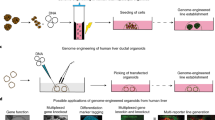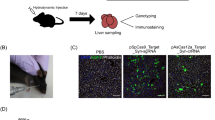Abstract
Studying the effects of the loss of a specific cell type is a powerful approach in biology. Here we present a method based on the controlled activation of the apoptotic machinery. We expressed a modified caspase-3-containing chemical inducer of dimerization (CID)-binding sites in the livers of transgenic mice. In the absence of CID, no liver injury was detectable, underlining the absence of leakage in our system. In contrast, injection of the CID produced activation of the chimeric caspase-3, which led to a dose-dependent pure hepatocyte ablation with subsequent regeneration. This method is effective in both growing and nongrowing cells, and is therefore applicable to a wide range of cells and tissues. Moreover, because apoptosis has been described in numerous pathological circumstances, this system is useful for generating mouse models of human disorders as well as for studying the recovery or regeneration of tissues after cell loss.
This is a preview of subscription content, access via your institution
Access options
Subscribe to this journal
Receive 12 print issues and online access
$209.00 per year
only $17.42 per issue
Buy this article
- Purchase on Springer Link
- Instant access to full article PDF
Prices may be subject to local taxes which are calculated during checkout






Similar content being viewed by others
References
Galle, P.R. et al. Involvement of the CD95 (APO-1/Fas) receptor and ligand in liver damage. J. Exp. Med. 182, 1223–1230 (1995).
Nanji, A.A. Apoptosis and alcoholic liver disease. Semin. Liver. Dis. 18, 187–190 (1998).
Fox, C.K., Furtwaengler, A., Nepomuceno, R.R., Martinez, O.M. & Krams, S.M. Apoptotic pathways in primary biliary cirrhosis and autoimmune hepatitis. Liver 21, 272–279 (2001).
Strand, S. et al. Hepatic failure and liver cell damage in acute Wilson's disease involve CD95 (APO-1/Fas) mediated apoptosis. Nat. Med. 4, 588–593 (1998).
Rudiger, H.A. & Clavien, P.A. Tumor necrosis factor-α, but not Fas, mediates hepatocellular apoptosis in the murine ischemic liver. Gastroenterology 122, 202–210 (2002).
Patel, T., Roberts, L.R., Jones, B.A. & Gores, G.J. Dysregulation of apoptosis as a mechanism of liver disease: an overview. Semin. Liver. Dis. 18, 105–114 (1998).
Lee, W.M. Acute liver failure. N. Engl. J. Med. 329, 1862–1872 (1993).
Fingerote, R.J. & Bain, V.G. Fulminant hepatic failure. Am. J. Gastroenterol. 88, 1000–1010 (1993).
Caraceni, P. & Van Thiel, D.H. Acute liver failure. Lancet 345, 163–169 (1995).
Fausto, N. Liver regeneration. J. Hepatol. 32, 19–31 (2000).
Kosai, K., Matsumoto, K., Funakoshi, H. & Nakamura, T. Hepatocyte growth factor prevents endotoxin-induced lethal hepatic failure in mice. Hepatology 30, 151–159 (1999).
Hecht, N. et al. Hyper-IL-6 gene therapy reverses fulminant hepatic failure. Mol. Ther. 3, 683–687 (2001).
Kobayashi, N. et al. Prevention of acute liver failure in rats with reversibly immortalized human hepatocytes. Science 287, 1258–1262 (2000).
Newsome, P.N., Plevris, J.N., Nelson, L.J. & Hayes, P.C. Animal models of fulminant hepatic failure: a critical evaluation. Liver Transpl. 6, 21–31 (2000).
Palmiter, R.D. et al. Cell lineage ablation in transgenic mice by cell-specific expression of a toxin gene. Cell 50, 435–443 (1987).
Behringer, R.R., Mathews, L.S., Palmiter, R.D. & Brinster, R.L. Dwarf mice produced by genetic ablation of growth hormone-expressing cells. Genes Dev. 2, 453–461 (1988).
Braun, K.M., Degen, J.L. & Sandgren, E.P. Hepatocyte transplantation in a model of toxin-induced liver disease: variable therapeutic effect during replacement of damaged parenchyma by donor cells. Nat. Med. 6, 320–326 (2000).
Matthews, T. & Boehme, R. Antiviral activity and mechanism of action of ganciclovir. Rev. Infect. Dis. 10, S490–S494 (1988).
Culver, K.W. et al. In vivo gene transfer with retroviral vector-producer cells for treatment of experimental brain tumors. Science 256, 1550–1552 (1992).
Saito, M. et al. Diphtheria toxin receptor-mediated conditional and targeted cell ablation in transgenic mice. Nat. Biotechnol. 19, 746–750 (2001).
Kobayashi, K. et al. Immunotoxin-mediated conditional disruption of specific neurons in transgenic mice. Proc. Natl. Acad. Sci. USA 92, 1132–1136 (1995).
Collier, R.J. in ADP-Ribosylating Toxins and G Proteins: Insights into Signal Transduction (eds. Moss, J. & Vaughan, M.) 3–19 (American Society for Microbiology, Washington, DC, 1990).
Fan, L., Freeman, K.W., Khan, T., Pham, E. & Spencer, D.M. Improved artificial death switches based on caspases and FADD. Hum. Gene Ther. 10, 2273–2285 (1999).
Yan, C., Costa, R.H., Darnell, J.E. Jr., Chen, J.D. & Van Dyke, T.A. Distinct positive and negative elements control the limited hepatocyte and choroid plexus expression of transthyretin in transgenic mice. EMBO J. 9, 869–878 (1990).
Clackson, T. et al. Redesigning an FKBP–ligand interface to generate chemical dimerizers with novel specificity. Proc. Natl. Acad. Sci. USA 95, 10437–10442 (1998).
Krajewska, M. et al. Immunohistochemical analysis of in vivo patterns of expression of CPP32 (Caspase-3), a cell death protease. Cancer Res. 57, 1605–1613 (1997).
Cheng, E.H. et al. Conversion of Bcl-2 to a Bax-like death effector by caspases. Science 278, 1966–1968 (1997).
Woo, M. et al. In vivo evidence that caspase-3 is required for Fas-mediated apoptosis of hepatocytes. J. Immunol. 163, 4909–4916 (1999).
Slee, E.A., Keogh, S.A. & Martin, S.J. Cleavage of BID during cytotoxic drug and UV radiation-induced apoptosis occurs downstream of the point of Bcl-2 action and is catalysed by caspase-3: a potential feedback loop for amplification of apoptosis-associated mitochondrial cytochrome c release. Cell Death Differ. 7, 556–565 (2000).
Jones, R.A. et al. Fas-mediated apoptosis in mouse hepatocytes involves the processing and activation of caspases. Hepatology 27, 1632–1642 (1998).
Zheng, T.S. et al. Caspase-3 controls both cytoplasmic and nuclear events associated with Fas-mediated apoptosis in vivo. Proc. Natl. Acad. Sci. USA 95, 13618–13623 (1998).
Janin, A. et al. CD95 engagement induces disseminated endothelial cell apoptosis in vivo: immunopathologic implications. Blood 99, 2940–2947 (2002).
Lee, P. et al. Conditional lineage ablation to model human diseases. Proc. Natl. Acad. Sci. USA 95, 11371–11376 (1998).
Xie, X. et al. Adenovirus-mediated tissue-targeted expression of a caspase-9-based artificial death switch for the treatment of prostate cancer. Cancer Res. 61, 6795–6804 (2001).
Mercer, D.F. et al. Hepatitis C virus replication in mice with chimeric human livers. Nat. Med. 7, 927–933 (2001).
Yoon, J.W. & Jun, H.-S. Cellular and molecular pathogenic mechanisms of insulin-dependent diabetes mellitus. Ann. NY Acad. Sci. 928, 200–211 (2001).
Narula, J. et al. Apoptosis in heart failure: release of cytochrome c from mitochondria and activation of caspase-3 in human cardiomyopathy. Proc. Natl. Acad. Sci. USA 96, 8144–8149 (1999).
Chirgwin, J.M., Przybyla, A.E., MacDonald, R.J. & Rutter, W.J. Isolation of biologically active ribonucleic acid from sources enriched in ribonuclease. Biochemistry 18, 5294–5299 (1979).
Gross, A. et al. Caspase-cleaved BID targets mitochondria and is required for cytochrome c release, while BCL-XL prevents this release but not tumor necrosis factor-R1/Fas death. J. Biol. Chem. 274, 1156–1163 (1999).
Acknowledgements
We thank Terry Van Dyke for the TTR vector and ARIAD Pharmaceuticals for providing us with AP20187 (http://www.ariad.com/regulationkits). We also thank Eva Mezey for proofreading the manuscript.
Author information
Authors and Affiliations
Corresponding author
Ethics declarations
Competing interests
The authors declare no competing financial interests.
Rights and permissions
About this article
Cite this article
Mallet, V., Mitchell, C., Guidotti, JE. et al. Conditional cell ablation by tight control of caspase-3 dimerization in transgenic mice. Nat Biotechnol 20, 1234–1239 (2002). https://doi.org/10.1038/nbt762
Received:
Accepted:
Published:
Issue Date:
DOI: https://doi.org/10.1038/nbt762
This article is cited by
-
External globus pallidus input to the dorsal striatum regulates habitual seeking behavior in male mice
Nature Communications (2023)
-
Caspase dependent apoptosis is required for anterior regeneration in Aeolosoma viride and its related gene expressions are regulated by the Wnt signaling pathway
Scientific Reports (2020)
-
Caspase-1 initiates apoptosis in the absence of gasdermin D
Nature Communications (2019)
-
Pericyte Plasticity in the Brain
Neuroscience Bulletin (2019)
-
Targeted two-photon chemical apoptotic ablation of defined cell types in vivo
Nature Communications (2017)



